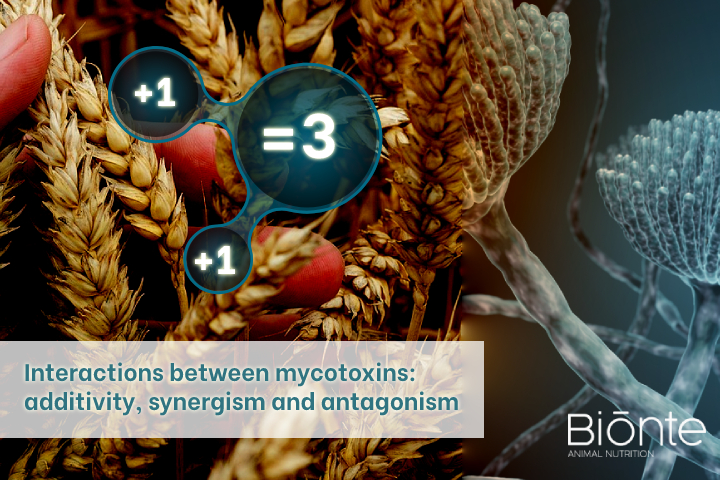- México, 33 Pol. Ind. Tecnoparc 43204 Reus (Tarragona) España
- +34 977 317 111
- bionte@bionte.com
For a long time, the effects of mycotoxins on human and animal health have been studied and described on a toxin-by-toxin basis. There is little knowledge regarding feed contamination by multiple mycotoxins, and often their combination or interaction is not considered (Viegas et al., 2011).
In animal production, the clinical signs of mycotoxicosis in the field can rarely been explained by the very low levels of mycotoxins present in the feed. However, the combination of mycotoxins can have twice the effect compared to when those toxins are present individually. Despite the magnitude of this challenge, the literature on the combination of toxins is still limited, especially, in regard to trichothecenes (Pedrosa,
2010). The combination of several mycotoxins leads to the formation of different interactions that can be additive, synergistic or antagonistic (Greco et al., 2014).

It should be noted that the type of interaction varies depending on the animal species, sex, age, mycotoxin dosage, duration, nutritional status of the animals and the route of exposure to the mycotoxin (Gruber et al., 2019).
Additivity refers to the effect of the combination of mycotoxins being the same as the sum of the individual effect of each toxin. When the combination of mycotoxins presents the effect of the most toxic mycotoxin without the effect of the other mycotoxin, the term ‘less additive’ is used (Smith et al., 2016). Some examples of mycotoxin combinations that exhibit additivity include aflatoxin B1+ochratoxin A, aflatoxin B1+toxin T-2, aflatoxin B1+fumonisin B1, ohcratoxin A+toxin T-2, DON+fumonisin B1, moniliformin+fumonisin, moniliformin+DON, fumonisin B1+diacetoxyscirpenol and fumonisin B1+toxin T-2 (Aihelen, 2021).
Antagonism refers to the combination of mycotoxins having a lesser effect than the sum of the individual effects of the toxins (Smith et al., 2016). In other words, the concept of antagonistic effect applies when the toxicity of one compound is used independently of the toxicity of the other compound (Ruiz et al., 2011). It has been reported that the combination of DON and zearalenone has an antagonistic effect on immune function in pigs. Similarly, the same antagonistic effect was reported on liver health and metabolism in mice (Gruber et al., 2019).
Synergism between mycotoxins is defined as the toxic effect exerted by the combination of various mycotoxins at certain concentrations that is greater than the sum of the effects of each mycotoxin when presented individually (Gimeno et al., 2011).
In other words, synergism is when the observed effect of the combination of mycotoxins is more than what is expected based on the effects of each mycotoxin. When one or more mycotoxins do not induce an effect while the combination does have a significant effect it is called potentiation, although this term is rarely used (Smith et al., 2016).
Synergism increases the toxic effects of mycotoxins, and some of the synergistic actions are presented by aflatoxins with ochratoxin or aflatoxins with T-2 toxin (Greco et al., 2014) .
In Fusarium-derived mycotoxins, most interactions range from additive to synergistic, affecting mortality, animal growth, and feed intake. Several reports indicate synergistic interactions of deoxynivalenol with fusaric acid, DON with fumonisin B1, or even diacetoxyscirpenol and aflatoxins (Pedrosa, 2010) .
Some of the synergisms found in the literature and their effects on animal productivity are described in the following box:
| Combination of mycotoxins | Described effect |
|---|---|
| Deoxynivalenol + Aflatoxin B1 | It has been described that the presence of both toxins leads to a greater severity of clinical signs in chickens, such as: decreased weight gain, reduced growth rate and anemia. In pigs, with the combination of these toxins, the animals present to a greater extend vomiting, rejection of feed and reduction of growth rate (Gimeno et al., 2011) . |
| T-2 Toxin + Aflatoxin B1 | The synergy between aflatoxin and T2 toxin is of great importance in poultry as it has a higher prevalence and severity (Greco et al., 2014) . Studies conducted in chickens found that the effects of T-2 toxin and AFB1 are aggravated when both are present. Animals typically exhibit oral lesions, reduced live weight gain, decreased serological enzyme activity, decreased protein levels, among other symptoms (Gimeno et al., 2011). |
| T-2 Toxin + Ochratoxin A | The combination between these mycotoxins affects several production parameters in the animals. In chickens, the combined activity of both mycotoxins induces a reduction of growth rate and a reduction of protein levels. It also alters the nutritional effectiveness. In pigs, the combined contamination of these two mycotoxins significantly reduces live weight gain, as well as decreasing the relative weight of the liver (Gimeno et al., 2011) . |
| T-2 Toxin + Deoxynivalenol | In chickens, the combined contamination of these mycotoxins substantially alters weight gain. In addition, oral lesions are reported with T-2 toxin, which are further increased with the inclusion of deoxynivalenol (Gimeno et al., 2011) . |
| Diacetoxyscirpenol + Ochratoxin A | In chickens, there is a notable increase in the relative weight of the liver, gizzard and kidneys. In addition, serious problems of nephropathy and oral lesions are reported (Gimeno et al., 2011) . |
| Diacetoxyscirpenol + Aflatoxin B1 | In pigs, it is reported that the combination of both toxins causes an increase in the relative weight of the liver and spleen. It also decreases iron uptake, reduces serum nitrogen levels, and aggravates other pathological disorders (Gimeno et al., 2011) . |
| Fumonisin B1 + Toxin T-2 | In chickens, it is reported that the combination of these toxins generates mortalities up to 15%. It also causes an increase in the relative weight of the liver and kidneys; the levels of cholesterol also increase (Gimeno et al., 2011) . |
| Deoxynivalenol + Zearalenone | In pigs, it is reported that the combination of these toxins causes rejection of feed, vomiting and bloody stools. In hens, the combined effect of both toxins causes a reduction in egg production and lesions in the mouth and crop (Gimeno et al., 2011) . |
| Fumonisin B1 + Aflatoxin B1 | In turkeys, the combination of these toxins significantly reduces the levels of total protein, albumin and cholesterol in serum. In addition, it has been reported that the feed conversion rate altered significantly (Gimeno et al., 2011) . |
Nowadays, most of the studies on the combination of mycotoxins in animal nutrition are conducted in vitro using cellular models instead of animal models.
There is a huge diversity of interactions that mostly have additive or synergistic effects, and given the complexity of the mycotoxin mixture, their combined toxicity is difficult to predict. The toxic effects presented by cells vary according to: cell type, exposure time, mycotoxin concentration, tests used and statistical models.
With these mentioned factors, the mycotoxin combination undoubtedly represents a threat to human and animal health since the toxicity of each combination will be different for each contaminated feed; not to mention that mycotoxins when combined can generate a toxic effect, even if they are present at low concentrations (Smith et al., 2016). Finally, there is a lack of studies that address topics such as exposure to sub-toxic concentrations of mycotoxins from multi-contaminated feed, as it is a more realistic scenario for food and feed consumption.


The company that provides effective solutions against mycotoxins.
Calle México, 33. Polígono Industrial Tecnoparc.
43204 Reus (Tarragona) - España
Contact information
E-mail: bionte@bionte.com
Telephone: +34 977 317 111